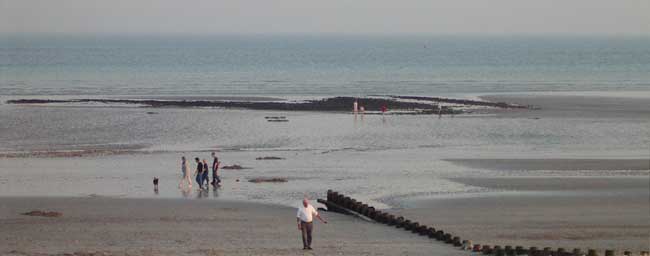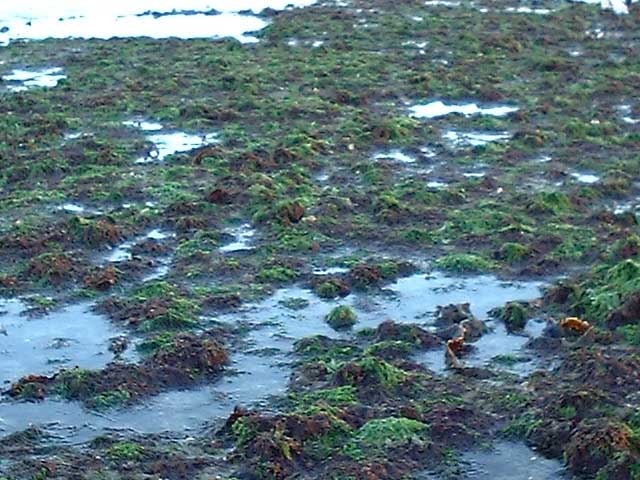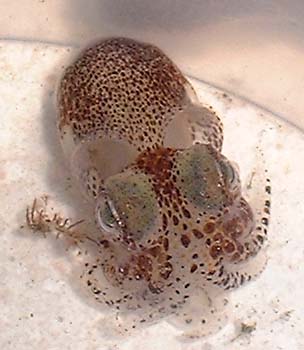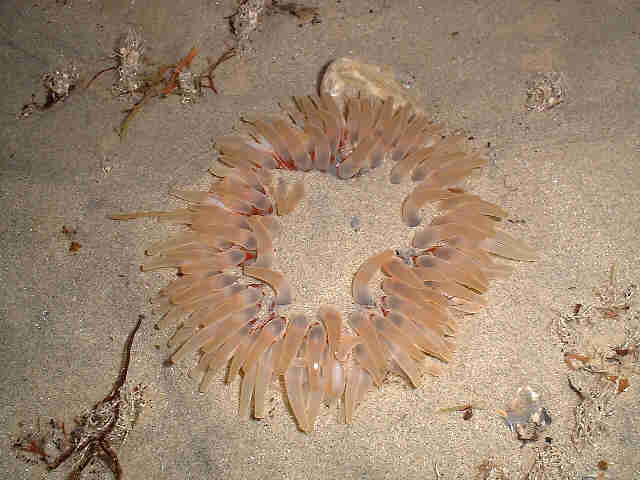

Lancing Beach is a sand with an area of loose flint rocks
It
was a very low spring tide and a visit to the shore
not to be missed by rockpoolers. However, although
most of the common crabs were present, there nothing
of special note to be seen in the shallow pools and under rocks.
Link
to a Special Report
19
March 2003
The
low equinoctial
spring
tide
receded as far as I have known it uncovering all the rocks on Lancing
Beach. It was too dark to explore the exposed shore properly, but juvenile
Small-headed
Clingfish (probable ident.) were present
under rocks, with hundreds
of crabs and a yet to be identified
chiton.
The chiton is 29 mm long and 20 mm at its widest part. The species is probably
a full sized Acanthochitona crinita.
The sea anemone Sagartia troglodytes
was common and the Snakelocks
Anemone frequently seen, its tentacles
clear as it quickly got darker.
Clingfish
on bryozoans
The
clingfish is about 10 mm long
 |
 |
The container containing the Clingfish was inverted and the pelvic sucker kept the fish in place.
16 March 2003
Common Name Scientific Name Frequency Comments Small-headed Clingfish Apletodon dentatus 10 + Probably many more. Ident. only 90% sure and being checked Edible Crab Cancer pagurus One Crab Hairy Crab Pilumnus hirtellus 150 + Crab Long-clawed Porcelain Crab Pisidia longicornis 200 + Snakelocks Anemone Anemonia viridis Frequent 12 + Sea Anemone Sagartia troglodytes Common
200 +Beadlet Anemone Actinia equina Only one seen Chiton Lepidochitona cinerea Only one seen Chiton Acanthochitona crinita Only one seen 
29 mm long
Sting Winkle Ocenebra erinacea At least one Grey Topshell 75+ The list above is incomplete because the light was fading rapidly
23
February 2003
The
low spring tide only receded to 1.09 metres and this was not low enough
to reveal the rocky areas on Lancing beach. The following abundant amphipods
were put under the QX3
computer microscope:
 |
 |
|
|
|
21
January 2003
With
due southerly wings up the Gale Force 7 at times pushing a high spring
tide (6.2 metres) against the shingle beach, there was very little foreshore
by Brooklands Boating Lake and the Ringed
Plovers (at least 4 probably more) occupied
the crest of the shingle bank and even ventured on to the coastal path.
6 December
2002
A black sea bird was resting
on the sea off the beach adjacent to Widewater Lagoon. In the swell it
was being carried into about 20 metres from the shingle beach at a high
spring tide. It was almost certainly an injured Razorbill.
5
November 2002
Collecting
a few rocks for aquarium props in fading light, a moonless evening under
torchlight, there were dozens of Squat
Lobsters, Galathea squamifera, and
at least one red-eyed Velvet
Swimming Crab, Necora
puber. I thought that I picked up
two, but the following day, I noticed that the crab had pale blue eyes
and this I now think may be a different crab altogether, Liocarcinus
arcuatus, the Arch-fronted
Swimming Crab which I have never discovered
before, nor have I heard reported before from the shore. The
identity of this crab has been confirmed by Dr.
Reindert Nijland.
This
small specimen of this crab (carapace width 25 mm) had a heavy carpus on
both chelae, a rough carapace in chocolate brown, swimming legs
that were pointed, slower moving than Necora, with also are pronounced
creamy white underside, and at dusk that was only its fractionally different
movement that made it stand out from the Shore Crab.
There were no "teeth" between the eyes, and the carapace was in a straight
line between the eyes, with red antennae and antennules.
BMLSS
Intertidal Crabs
6
October 2002
With
Indian
Summer summer preceding some of the highest and lowest equinoctial
spring tides for over 20 years was too good a rockpooling
chance to miss as low tide receded to Chart
Datum about 6:00 pm,
just before an attractive red sunset.
 The
low tide revealed shallow pools and rocks covered in weed. There were relatively
few rocks to turn and the fauna was not spectacular but interesting enough.
The most noticeable animal life included:
The
low tide revealed shallow pools and rocks covered in weed. There were relatively
few rocks to turn and the fauna was not spectacular but interesting enough.
The most noticeable animal life included:
Shore
Crab Carcinus maenas (25+)
Hairy
Crab Pilumnus hirtellus (20+)
Velvet
Swimming Crab Necora puber (one)
Short-legged
Spider Crab Eurynome aspera (one)
Long-legged
Spider Crab Macropodia rostrata (20+)
Long-clawed
Porcelain Crab Pisidia longicornis (20+)
Prawn
Paleamon serratus (30+)
Common
Hermit Crab Pagurus bernhardus (one) in a Netted Dogwhelk shell
Snakelocks
Anemone Anemonia viridis (one)
Rock
Goby, Gobius paganaellus (two young fish)
5-Bearded
Rockling, Ciliata mustela (one large fish, over 20 cm long)
 The
push net in the shallow seas produced an exiguous haul as well, but was
more interesting:
The
push net in the shallow seas produced an exiguous haul as well, but was
more interesting:
Little
Cuttlefish, Sepiola (one)
South-claw
Hermit Crab Diogenes pugilator (three),
my
first record from Sussex.
Unidentified
Swimming Crab (one, small)
Brown
Shrimp,
Crangon
crangon (two)
Sole,
Solea
solea, (8+) (juvenile fish) ? species ?
25
September 2002
Off
Lancing beach on the seaward side of Widewater,
four Undulate Rays,
Raja
undulata, were seen in the shallow water.
23
August 2002
A
seal, probably a Common (or Harbour) Seal,
Phoca
vitulina, is spotted off Lancing beach between the breakwaters at high
tide by the Golden Sands Caravan Park. It was mistaken for a dog at first
which is often the case. Seals are a rare sight off the mid-Sussex coast,
but a few have been seen off
Shoreham beach before.
The nearest rookery is a small group of seals in Chichester harbour which
are occasionally seen around Selsey (Seal Island).
25
April 2002
Not
anything like as good as last month. Rather poor and disappointing:
Some species recorded:.
Hairy
Crab (25
+)
Shore
Crab (10
+)
 Squat
Lobster, Galathea squamifera (one)
Squat
Lobster, Galathea squamifera (one)
Long-clawed
Porcelain Crab
Beadlet
Anemone
Snakelocks
Anemone
Sagartia
troglodytes Anemone
Bryozoa (click on this link for a photograph).
Sea Mat, Membranipora membranacea
Squid eggs washed up.
The
best buckets to use to temporarily house small fish and crabs for inspection
are light in colour. Fish will suffocate if left in a bucket for too long
on a hot day. The fish should be returned under rocks so they are safe
from marauding gulls.
Click
on the fish for identification
 Even
more amazingly Ray
Hamblett discovered a small Montagu's
Sea Snail, Liparis montagui, (a
small fish) underneath a rock. This is a small orange fish and although
I had never ever discovered one on thousands of visits to the shore. I
immediately recognised it as this fish is actually known to breed off Lancing.
This was discovered by the late John Barker and
the species confirmed by fish expert at the Natural History Museum Alwyne
Wheeler. The children discovered over a dozen
rock
pool fish of four species to much excitement, as well lots of different
Even
more amazingly Ray
Hamblett discovered a small Montagu's
Sea Snail, Liparis montagui, (a
small fish) underneath a rock. This is a small orange fish and although
I had never ever discovered one on thousands of visits to the shore. I
immediately recognised it as this fish is actually known to breed off Lancing.
This was discovered by the late John Barker and
the species confirmed by fish expert at the Natural History Museum Alwyne
Wheeler. The children discovered over a dozen
rock
pool fish of four species to much excitement, as well lots of different  crabs.
crabs.

Furthermore,
the beach was home to four species of sea anemones
including large Dahlia
Anemones and frequent Snakelocks
Anemones, enough to identify this location as the most easterly
regular location of the latter sea anemone on the northern English Channel
coast.
Adur Estuary Survey by the late John Barker
Sanderlings
(x
20 +) (a small wading bird) fed energetically
alongside the sandy pools and a the margins of sand and sea.
| Common Name | Scientific Name | Frequency | Comments |
| Tompot Blenny | Parablennius gattorugine | One | Fish |
| 5-Bearded Rockling | Ciliata mustela | Five + | Fish |
| Montagu's Sea Snail | Liparis montagui | One | Fish |
| Long-spined Bullhead | Taurulus bubalis | Five + | Fish |
| Shore Crab | Carcinus maenas | 3+ adults | Crab |
| Edible Crab | Cancer pagurus | 3 + | Crab |
| Hairy Crab | Pilumnus hirtellus | 25 + | Crab |
| Long-clawed Porcelain Crab | Pisidia longicornis | Anomuran | |
| Common Hermit Crab | Pagurus bernhardus | Anomuran | |
| Prawn | Palaemon | Very few | |
| Snakelocks Anemone | Anemonia viridis | Frequent 25 + | |
| Dahlia Anemone | Urticina felina | At least 3 | |
| Sea Anemone | Sagartia troglodytes | Common 50+ | |
| Beadlet Anemone | Actinia equina | Only one seen | |
|
|
|
|

Identity only discovered in the aquarium. |
| Gooseberry Sea Squirt (brown) | Dendrodoa grossularia | Dominant |
Link
to Lancing Beach 2004 Reports
Half
Brick Beach 2004
Link
to Lancing Beach 2003
|
|
|
|
|
News 2018 |
Membership Form |
|
|
|
|
|
|